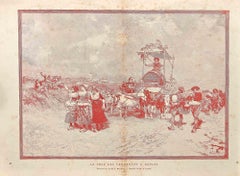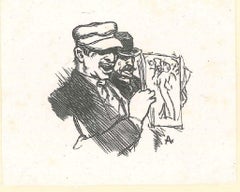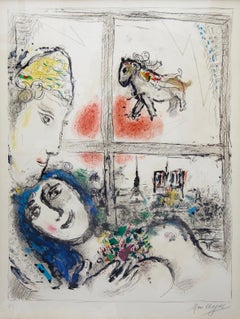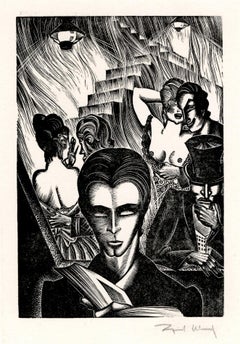Auguste Lepère Art
to
1
2
1
2
1
2
1
Overall Height
to
Overall Width
to
2
3
3
2
1
1
1
1
1
2
1
3
6,997
3,373
2,513
1,212
1
1
1
1
1
Artist: Auguste Lepère
Les Quartier des Gobelins
By Auguste Lepère
Located in Middletown, NY
Paris: Gazette des Beaux Arts, 1896. Etching with aquatint on cream laid paper, 7 7/8 x 4 7/8 (200 x 125 mm), full margins. Edition of roughly 750. In good condition with uniform ton...
Category
Late 19th Century French School Auguste Lepère Art
Materials
Etching, Aquatint, Laid Paper
La Fede des Vendanges à Naple-Lithograph by Auguste Lepère-Early 20th Century
By Auguste Lepère
Located in Roma, IT
La Fede des Vendanges à Naple is aprint realized by Auguste Lepere in the early 20th Century.
Lithograph on paper.
Signed on the plate on the lower margin.
Good conditions with di...
Category
Early 20th Century Modern Auguste Lepère Art
Materials
Lithograph
Two Men with an Illustration - Original Woodcut by Auguste Lepère - 19th Century
By Auguste Lepère
Located in Roma, IT
Two Men with an Illustration is an original artwork realized by Auguste Lepère in the second half of the XIX century.
Original xylograph. Artist's proof for the illustration of a wo...
Category
Late 19th Century Modern Auguste Lepère Art
Materials
Woodcut
Related Items
"Paris de ma fenêtre" 1969-1970 Paris from My Window - Color lithograph
By Marc Chagall
Located in Rancho Santa Fe, CA
Marc Chagall
"Paris de ma fenêtre"
1969-1970
Lithograph in colors on Arches paper
32.5 x 23.75 inches (image size)
39.5 x 27.5 inches (sheet size)
Edition of 50 + 25 AP
Signe...
Category
1960s Modern Auguste Lepère Art
Materials
Archival Paper, Lithograph
'Madman's Drum (Plate 41)' — 1930s Graphic Modernism
By Lynd Ward
Located in Myrtle Beach, SC
Lynd Ward, 'Madman's Drum, Plate 41', wood engraving, 1930, edition small. Signed in pencil. A fine, black impression, on off-white tissue-thin Japan paper; the full sheet with margins (1 5/8 to 2 1/2 inches); a small paper blemish in the upper right margin, away from the image, otherwise in excellent condition. Scarce. Matted to museum standards, unframed.
Image size 5 1/2 x 3 3/4 inches (140 x 95 mm); sheet size 9 5/8 x 7 1/8 inches (244 x 181 mm).
From Lynd Ward’s book of illustrations without words, 'Madman’s Drum', Jonathan Cape and Harrison Smith, New York, 1930. Illustrated in 'Storyteller Without Words: The Wood Engravings of Lynd Ward', Harry Abrams, New York, 1974.
Reproduced in 'Storyteller Without Words, the Wood Engravings of Lynd Ward', Harry N. Abrams, New York, 1974.
ABOUT THE ARTIST
Lynd Ward is acknowledged as one of America’s foremost wood engravers and book illustrators of the first half of the twentieth century. His innovative use of narrative printmaking as a stand-alone storytelling vehicle was uniquely successful in reaching a broad audience. The powerful psychological intensity of his work, celebrated for its dynamic design, technical precision, and compelling dramatic content, finds resonance in the literature of Poe, Melville, and Hawthorne. Like these classic American writers, Ward was concerned with the themes of man’s inner struggles and the role of the subconscious in determining his destiny. An artist of social conscience during the Great Depression and World War II, he infused his graphic images with his unique brand of social realism, deftly portraying the problems that challenged the ideals of American society.
The son of a Methodist preacher, Lynd Ward, moved from Chicago to Massachusetts at an early age. He graduated from the Teachers College of Columbia University, New York, in 1926, where he studied illustration and graphic arts. He married May Yonge McNeer in 1936 and left for Europe for their honeymoon in Eastern Europe. After four months, they settled in Leipzig, where Ward studied at the National Academy of Graphic Arts and Bookmaking. Inspired by Belgian expressionist artist Frans Masereel's graphic novel ‘The Sun,’ and another graphic novel by the German artist Otto Nückel, ‘Destiny,’ he determined to create his own "wordless" novel. Upon his return to America, Ward completed his first book, ‘God's Man: A Novel in Woodcuts,’ published in 1929. ‘Gods’ Man’ was a great success for its author and publisher and was reprinted four times in 1930, including a British edition. This book and several which followed it, ‘Madman’s Drum,’ 1930, ‘Wild Pilgrimage...
Category
1930s American Modern Auguste Lepère Art
Materials
Woodcut
Irving Amen, The Heart is a Garden, Signed A/P & Framed Woodblock Print
By Irving Amen
Located in Plainview, NY
A woodblock print in color, of a girl looking up at a giant flower bouquet by Irving Amen ( American, 1918-2011) . The lithograph entitled "The Heart is a Garden " is signed Amen and...
Category
20th Century Modern Auguste Lepère Art
Materials
Woodcut
H 34 in W 25 in D 1.5 in
The Wedding Procession - Le Cortege nuptial - 17thC Etching from Les Pastorales
By Claudine Bouzonnet-Stella
Located in Meinisberg, CH
Engraved by
Claudine Bouzonnet-Stella
(French, 1636-1697)
After
Jacques Stella (French 1596-1657)
The Wedding Procession - Le Cortege nuptial
• Copper engraving on laid paper
• Sh...
Category
17th Century Naturalistic Auguste Lepère Art
Materials
Ink, Laid Paper, Etching
Free Shipping
H 9.73 in W 12.21 in D 0.4 in
Homme barbu couronné feuilles de vigne
By Pablo Picasso
Located in Palo Alto, CA
Created in 1962, this linocut on Arches wove paper is hand-signed by Pablo Picasso (Malaga, 1881 - Mougins, 1973) in pencil in the lower right margin and is numbered from the edition of 50 in the lower left margin.
Catalogue Raisonné:
Pablo Picasso Homme barbu couronné feuilles de vigne...
Category
1960s Modern Auguste Lepère Art
Materials
Lithograph
Wedding Party
Located in Buffalo, NY
An original mid century modern woodblock print.
This work is hand signed illegibly and titled "Wedding Party".
Category
1960s Modern Auguste Lepère Art
Materials
Paper, Woodcut
Modern American Industrial Landscape
Located in Buffalo, NY
An original woodblock print dated 1965, titled "Our Town" but signed illegibly.
Category
1960s American Modern Auguste Lepère Art
Materials
Woodcut, Paper
Guillaume Corneille 1948 Aquatinte / eau forte
By Corneille
Located in Saint Ouen, FR
Guillaume Corneille
1948
Aquatinte/ eau forte
Proof of artist
Signed, dated and noted PA (artist’s proof) from the artist’s hand to the crayoN
Print run 125 copy
Laid paper with wate...
Category
1980s Modern Auguste Lepère Art
Materials
Lithograph
'City Lights' — Vintage Wood Engraving, New York City, 1934
By Fritz Eichenberg
Located in Myrtle Beach, SC
Fritz Eichenberg, 'City LIghts', wood engraving, 1934, edition 200. Signed, titled 'Lights', and annotated 'No 2/200 for Howard M. Chapin' in pencil. Initialed in the block, lower right. A fine, richly-inked black impression, on cream wove paper, with full margins (1 1/4 to 1 7/8 inches); a small loss (5/8 inch) in the top right sheet corner, well away from the image, otherwise in excellent condition. Printed by master printer Ernest Roth...
Category
1930s American Modern Auguste Lepère Art
Materials
Woodcut
'Simplicius' Farewell to the World' — Graphic Modernism
By Fritz Eichenberg
Located in Myrtle Beach, SC
Fritz Eichenberg, 'Simplicius’ Farewell To The World' from the suite 'The Adventurous Simplicissimus', wood engraving, 1977, artist's proof apart from the edition of 50. Signed in pencil. Signed in the block, lower right. A fine, richly-inked impression, on cream wove paper, with full margins (1 1/2 to 2 inches), in excellent condition. Image size 14 x 12 inches (356 x 305 mm); sheet size 17 1/2 x 15 inches (445 x 381 mm). Archivally sleeved, unmatted.
ABOUT THIS WORK
'Simplicius Simplicissimus' (German: Der abenteuerliche Simplicissimus Teutsch) is a picaresque novel of the lower Baroque style, written in five books by Hans Jakob Christoffel von Grimmelshausen published in 1668, with the sequel Continuatio appearing in 1669.
The novel is told from the perspective of its protagonist Simplicius, a rogue or picaro typical of the picaresque novel, as he traverses the tumultuous world of the Holy Roman Empire during the Thirty Years' War. Raised by a peasant family, he is separated from his home by foraging dragoons. He is adopted by a hermit living in the forest, who teaches him to read and introduces him to religion. The hermit also gives Simplicius his name because he is so simple that he does not know his own name. After the death of the hermit, Simplicius must fend for himself. He is conscripted at a young age into service and, from there, embarks on years of foraging, military triumph, wealth, prostitution, disease, bourgeois domestic life, and travels to Russia, France, and an alternate world inhabited by mermen. The novel ends with Simplicius turning to a life of hermitage, denouncing the world as corrupt.
ABOUT THE ARTIST
Fritz Eichenberg (1901–1990) was a German-American illustrator and arts educator who worked primarily in wood engraving. His best-known works were concerned with religion, social justice, and nonviolence.
Eichenberg was born to a Jewish family in Cologne, Germany, where the destruction of World War I helped to shape his anti-war sentiments. He worked as a printer's apprentice and studied at the Municipal School of Applied Arts in Cologne and the Academy of Graphic Arts in Leipzig, where he studied under Hugo Steiner-Prag. In 1923 he moved to Berlin to begin his career as an artist, producing illustrations for books and newspapers. In his newspaper and magazine work, Eichenberg was politically outspoken and sometimes wrote and illustrated his reporting.
In 1933, the rise of Adolf Hitler drove Eichenberg, who was a public critic of the Nazis, to emigrate with his wife and children to the United States. He settled in New York City, where he lived most of his life. He worked in the WPA Federal Arts Project and was a member of the Society of American Graphic Artists.
In his prolific career as a book illustrator, Eichenberg portrayed many forms of literature but specialized in works with elements of extreme spiritual and emotional conflict, fantasy, or social satire. Over his long career, Eichenberg was commissioned to illustrate more than 100 classics by publishers in the United States and abroad, including works by renowned authors Dostoyevsky, Tolstoy, Charlotte and Emily Brontë, Poe, Swift, and Grimmelshausen. He also wrote and illustrated books of folklore and children's stories.
Eichenberg was a long-time contributor to the progressive magazine The Nation, his illustrations appearing between 1930 and 1980. Eichenberg’s work has been featured by such esteemed publishers as The Heritage Club, Random House, Book of the Month Club, The Limited Editions Club, Kingsport Press, Aquarius Press, and Doubleday.
Raised in a non-religious family, Eichenberg had been attracted to Taoism as a child. Following his wife's unexpected death in 1937, he turned briefly to Zen Buddhist meditation, then joined the Religious Society of Friends in 1940. Though he remained a Quaker until his death, Eichenberg was also associated with Catholic charity work through his friendship with Dorothy Day...
Category
1970s American Modern Auguste Lepère Art
Materials
Woodcut
Guillaume corneille "La femme et l’oiseau" Silkscreen printing
By Corneille
Located in Saint Ouen, FR
William the crow
The woman and the bird
Silkscreen printing
Circa 1078
Edition of 100 copies
Numbered, dated and signed in pencil by the artist.
70 x 50 cms
Perfect condition
790...
Category
1970s Modern Auguste Lepère Art
Materials
Lithograph
H 27.56 in W 19.69 in D 0.4 in
Sanctuary (St. Anthony's Garden at rear of St. Louis Cathedral on Royal Street)
By Frederick Mershimer
Located in New Orleans, LA
This French Quarter garden is a serene haven with a lighted statue of Christ that exists not very far from the raucous revelry of New Orleans' Bourbon S...
Category
1990s American Modern Auguste Lepère Art
Materials
Aquatint, Mezzotint
Previously Available Items
Le Pont Marie - Original Etching by Auguste Lepère - 1902
By Auguste Lepère
Located in Roma, IT
Le Pont Marie is an original artwork realized by Auguste Lepère in 1902. Etching on paper.
Passepartout included (cm 32.5 x 42). Signed and dated on plate on the lower right corner. Titled on the upper left corner. Éprouve avant la lettre.
Excellent conditions.
Very fresh and beautiful impression representing a scene with washerwomen on a river and the bridge of Marie in the distance. On the right side of the composition there are some buildings and trees sketched...
Category
Early 1900s Auguste Lepère Art
Materials
Etching
H 9.06 in W 11.82 in D 0.04 in
Starry Night - Original Woodcut by Auguste Lepère - End of 1800
By Auguste Lepère
Located in Roma, IT
Starry Night is a beautiful original wood print realized by Auguste Lepère (1849 - 1918) as the monogram on plate shows on the lower right corner.
This is a print proof before lette...
Category
Late 19th Century Auguste Lepère Art
Materials
Woodcut
H 11.03 in W 7.68 in D 0.04 in
Auguste Lepère art for sale on 1stDibs.
Find a wide variety of authentic Auguste Lepère art available for sale on 1stDibs. You can also browse by medium to find art by Auguste Lepère in lithograph, woodcut print and more. Much of the original work by this artist or collective was created during the 20th century and is mostly associated with the modern style. Not every interior allows for large Auguste Lepère art, so small editions measuring 3 inches across are available. Customers who are interested in this artist might also find the work of Pierre Puvis de Chavannes, Charles Courtry, and Léopold Flameng. Auguste Lepère art prices can differ depending upon medium, time period and other attributes. On 1stDibs, the price for these items starts at $156 and tops out at $178, while the average work can sell for $167.






